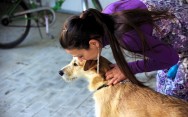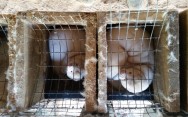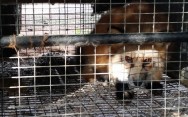Blog Archives
Home -
Posts tagged "animal rights" (Page 5)
Until Wildlife Services agreed to “cut back” on killings of wild animals in Montana, it might not have been visible to most Montanans that thousands of animals were being killed in Montana every year. In 2018, the most recent year for which data is available, Wildlife Services killed 7,965 coyotes, 46 wolves, one grizzly bear and other species in Montana. Until the settlement with WildEarth Guardians required Wildlife Services to stop exploding sodium cyanide bombs on certain tracts of public and private land, Wildlife Services’s explosion of bombs to destroy animal habitats wasn’t a subject of discussion.
The massacre taking place under our fingertips is still taking place, only at reduced levels. Wildlife Services is an anachronistic name for a violent agency that mostly appears to protect the interests of big farmers and ranchers. Public understanding of these agencies is that they restore balance in livestock predator conflicts and to human/animal interactions. Yet the activity that most undermines balance is protected by Wildlife Services: the livestock industry that endangers the planet through climate change and pollution. The whole system is one in which countless numbers of animals (including cattle) die to feed a machine that requires more killing to perpetuate its existence. By definition any system running on this level of destruction is not sustainable.
WildEarth Guardians have won a battle that requires the Wildlife Services to turn to science to justify their killings; they are now required to review the killings based on updated reports rather than carry them out wantonly. Unfortunately, it has not won the war. Winning the war is only possible when human groups participate in protecting an environment shared with non-human creatures equally.
Read more:
https://montanafreepress.org/2020/05/14/wildlife-services-to-cut-back-killings-pending-environmental-review/
When Whip’s owners’ went to feed their beloved horse in the morning, they found he was gone. Then they wandered into a nearby field where they made a horrific discovery. They found the body of their beloved friend and family member, completely butchered. This was a cold blooded killing: the horse had been butchered in the dead of night, somewhere between midnight and 5am, ostensibly for his meat. There have been other similar incidents in nearby counties, indicating that a killer may well be targeting horses in the local area.
The Sheriff’s Office and the Florida Agricultural Crimes Intelligence Unit are working on this crime and Collier County deputies have increased their presence in areas where people keep horses. Just like serial killers who target humans, it seems vulnerable horses are being preyed upon. Horses can be picked off by killers at their leisure as they graze in fields, powerless to protect themselves.
It is difficult to imagine what Whip went through in his final minutes or hours. The killer worked in the dead of night to butcher Whip, and more than likely took pleasure in the horse’s suffering. Whip’s owners describe themselves as grief-stricken. Their loss is the loss of a family member. They explain how they miss the 8 year old horse Whip, who they adopted as a four year old, and his “great personality.” Their loss is the loss of a sovereign individual who can never be replaced, and worse, a family member who was killed in the most brutal and gruesome way. Whip’s family are offering a $12,600 reward to anyone who can provide info about the person who killed him. This cannot bring back Whip, but if his killer is caught, another horse will not have to endure the unimaginable pain of brutal violence, and another family will not have to grieve the loss of beloved family member.
https://www.nbcnews.com/news/animal-news/family-s-horse-found-butchered-florida-horrific-crime-n1145841
Once again, the fates of humans affects so much more than just us. Coronavirus has put pet shelters into emergency mode. The bad news is that pet shelters are so understaffed that their intake of pets is greatly reduced. The good news is that people are stepping up across the country to adopt and foster pets and take virtual tours to get to know animals. The adoption and fostering of animals is actually up, but then again, pet shelters can’t keep a regular turnover of animals, so stray animals will be adversely affected by this crisis.
Even though adoptions are up, there have been fears about people dumping their pets by the side of the road because of coronavirus fears. As well as being unconscionable, this is completely uninformed. First, there’s the moral failure of abandoning an animal that is dependent on you. If you wouldn’t abandon a relative in your household, you should not abandon a pet. Even if pets were able to spread coronavirus, it’s possible to practice adequate social distancing by keeping them indoors or being careful when you exercise them.
However, there is absolutely no evidence right now that companion animals like dogs and cats can transmit the virus. Though two dogs tested positive for Covid-19, this says nothing about their ability to spread the virus. Testing on animals does reveal a huge tragedy though – the death of pigs and other industrially farmed animals from coronavirus or related illnesses. Pigs have similarities to humans that make them the animals most likely to contract or spread coronavirus. Our insistence on industrially farming animals for meat is the reason for the tragic death of pigs in their huge numbers in this quiet and unreported pandemic.
One way you can protect animals is to stay informed and correct the spread of egregious misinformation that endangers animals. Practicing social distancing with pets and encouraging others to do the same is something else you can do. In many states you can adopt or foster pets and meet them virtually before you pick them up. You can also encourage vegan eating and continue to reject and fight against the hegemony of industrial farming and demand better treatment for all animals.
Read More:
https://www.deseret.com/utah/2020/3/27/21194027/coronavirus-covid-19-animal-shelters-foster-pets
usatoday.com/story/entertainment/celebrities/2020/03/27/animal-adoptions-shelters-get-creative-pair-parents-pets-amid-coronavirus/2907199001/
https://phys.org/news/2020-03-animals-vulnerable-covid-.html
The more access we have to information, the more examples we see of the way animals work together, care for and even comfort each other in sadness and illness. A touching photo of comfort dogs at the vet is the latest example to catch people’s attention. Some vets have dogs whose job is to provide comfort and solace for sick and dying dogs. These dogs are able to care for other dogs by letting them know that everything’s going to be OK, and by just being there in the same way humans are for each other.
It’s remarkable and yet not remarkable. What people are witnessing isn’t just animals being adorable, but animals interacting together just as humans do. Acts of kindness between people can also have this feelgood factor. Caring for other beings is something that doesn’t stop at our own species. The days when there was an easy excuse to see animals as automatic and unfeeling are passing away. All the evidence shows that animals are a parallel society who can organize and bond in deep ways. It’s great that people are sharing these stories, but discovering that animals feel solidarity, comfort and pain should do more than make us feel good. It should awaken us to the bonds we break and the pain we cause when we are violent to animals.
Veterinarian Has A ‘Comfort Dog’ That Assists Sick, Scared Pets
Australia’s Capital Territory has just taken an important leap forward in the legal treatment of animals. The new laws in Australia’s Capital Territory recognize that animals can perceive and feel the world around them and have “intrinsic value.” These concepts finally depart from the legal structures which incarcerate animals as objects designed for humans’ use and abuse, and which characterize most legal systems around the world.
The laws impose sizeable fines and prison sentences for confining animals, lack of animal care and participating in cruelty to animals. They also move to restrict pet shops and the pet shop industry.
There is reason to celebrate the passing of these laws, but a good beginning mustn’t be a permanent band-aid. This article is right to point out that “animal sentience” does more to regulate treatment of pets than it does to change humans’ relationship with animals. Australian industries that harm animals won’t be expected to change. A “duty of care” is imposed on humans when they are in a relationship of care. But so many of human relations with animals are mediated through profit and product, rather than care. The new laws recognize that animals should not be humans’ property in the law. In practice they will defend the animals humans have chosen as pets, abandoning the animals victimized by industry. We can only hope that the interpretation of these laws and further activism will expand protection to animals who are still being brutalized.
Read More:
https://www.canberratimes.com.au/story/6407314/act-passes-australia-first-animal-sentience-laws/
This Vice headline sums the Amazon situation up with the kind of bluntness that’s needed at the moment: “Sad About the Amazon Fires? Stop Eating Meat.” The article is a timely correction to the assumption that logging is the reason we are losing the Amazon rainforests. Many posting on social media accounts about the Amazon fires are unthinkingly connecting the damage to “other people”: greedy logging companies etc., when in fact the trail leads directly back to the people posting – many of whom eat meat. Cattle ranching is the leading cause of deforestation in the Amazon, and clearing lands to make way for cattle is what is causing the fires.
The growing demand for meat is driving this destruction, in particular the demand for beef. With plenty of healthy protein substitutes available, the slaughter of cattle is completely unnecessary. Industrial farming harms the environment in other ways through water pollution from slaughterhouses. Animal suffering is an inevitable byproduct of treating animals like products, to be mutilated and packaged. In the tragedy of the Amazon rainforest we can see how this approach to life has outward ripples. When we treat life like an industrial product, when we kill animals brutally, we lack the respect for other life that is ultimately needed to save our own lives and habitats.
Read More:
https://www.vice.com/en_in/article/bjwzk4/feeling-sad-about-the-amazon-fires-stop-eating-meat
by Dr. Kevin Boileau
In Santics v. Vancouver (City) Animal Control Officer, 2019 BCCA 294, The appellant’s dog was designated a dangerous dog after it seriously injured a person in a public park. The Provincial Court judge who heard the matter assumed the availability of conditional orders falling short of destruction in dangerous dog proceedings under s. 324.1 of the Vancouver Charter, but held that the lack of reasonable alternatives for the dog’s rehabilitation meant that there was no choice but to order destruction. The judge’s decision was upheld by the Supreme Court of British Columbia on appeal. The appellant appeals from the order of the Supreme Court. Held: Appeal dismissed. On the evidence, it was open to the Provincial Court judge to conclude that the appellant’s dog posed an unacceptable risk to the public and ought to be destroyed. Furthermore, on an application by an animal control officer to the Provincial Court for a destruction order pursuant to s. 324.1(10) of the Vancouver Charter or s. 49(10) of the Community Charter, the Provincial Court, upon finding that the dog is dangerous in that it poses an unacceptable risk to the public, does not have the jurisdiction to make a conditional order falling short of the dangerous dog’s destruction; the dog must be ordered to be destroyed. The Provincial Court does, however, have the jurisdiction to conclude that the dog does not pose an unacceptable risk to the public, in that the dog is not likely to kill or seriously injure in the future, whereupon the dog is to be returned to its owner.
The Honourable Mr. Justice Abrioux states as follows, in the court record:
I: INTRODUCTION
[1] This appeal marks the first opportunity for this court to substantively address the dangerous dog provisions of the Vancouver Charter, S.B.C. 1953, c. 55, and identical provisions contained in the Community Charter, S.B.C. 2003, c. 26.
[2] In an order dated January 10, 2019, the Supreme Court of British Columbia dismissed an appeal brought by the appellant, Ms. Susan Santics, from an order of the Provincial Court of British Columbia requiring the destruction of her dog. Ms. Santics appeals to this court from the order of the Supreme Court.
[3] This appeal concerns not only the fate of “Punky” — a four-year-old Australian cattle dog owned by Ms. Santics and which seriously injured a woman in a public park — but also raises questions as to the Provincial Court’s powers on an application for the destruction of a dangerous dog. In particular, it raises the question of whether s. 324.1(10) of the Vancouver Charter and s. 49(10) of the Community Charter confer jurisdiction on the Provincial Court to make conditional orders falling short of destruction.
[4] This appeal also raises the correctness of Capital Regional District v. Kuo, 2006 BCSC 1282 (“Kuo”). For 13 years, Kuo has been relied on by both the Provincial Court and the Supreme Court — the latter in its role as an appeal court — as the authority for the Provincial Court’s jurisdiction to make conditional orders falling short of destruction in dangerous dog proceedings: see, for example, Panton v. Central Okanagan (Regional District), 2016 BCSC 69.
[5] I would conclude as follows:
(a) in so far as Ms. Santics’ dog is concerned, the Supreme Court judge committed no reviewable error in dismissing the appeal from the Provincial Court’s order that the dog be destroyed;
(b) contrary to the reasoning in Kuo, once the Provincial Court has found that a dog is likely to kill or seriously injure within the meaning of the Vancouver Charter or the Community Charter, it does not have the jurisdiction to make orders — conditional or otherwise — save for that the dog in question be destroyed;
(c) notwithstanding (b), there may be circumstances in which a dog that satisfies the statutory definition of “dangerous dog” nonetheless does not pose an unacceptable risk to the public, in which event the Provincial Court must dismiss the destruction application and release the dog to its owner; and,
(d) while there may well be good policy reasons for recognizing conditional orders in certain situations, as legislation in some Canadian provinces has done, it is for the Legislature and not this court to determine the framework that ought to apply in British Columbia.
(e) I would accordingly dismiss the appeal.
There is more to the complete record, but let’s focus on the summary above, which demonstrates serious lack of due process and a serious lack of regard for the life of a dog. The Appellate decision on its face is violent and irrational because it won’t give the provincial court authority to weigh middle-ground options including rehabilitation, and transfer of custodianship out of the city. In the U.S. this could be viewed as a serious due process issue, especially because of the legal trend to recognize that domestic dogs have interests. Even the language of the vicious dog statute is suspect because one option is to “destroy” the dog. To destroy is something you do to things not living beings. Even death row human inmates are not destroyed, they are executed. Thus beyond the fact that this judge just overturned several years’ of common law, the actually vicious dog law would apparently be in conflict with the trend in the law to recognize interests if not some rights of domestic dogs.
Second, whatever harm happened was due to the negligence of this dog’s custodian and yet the Canadian court system chooses to make the dog responsible. This dog should never have been in the city. He is a cattle dog and should be out in the country. Currently he is being held in impound, which is further harm to him. The dog is a victim here, not a perpetrator.
Third, because this dog’s very life is at stake, the Appellate Court justice and the Provincial court erred in allowing the dog’s custodian to represent herself and her dog’s interest. At a very minimum this custodian should have been represented by counsel. The court should have also required that the dog be represented by separate legal counsel when his very liv eis at stake. Obviously, the court recognizes the need for some due process requirements in vicious dog adjudications. It seems logical that it would recognize the interests of the dog, especially in a capital case like this.
Fourth, the provincial court erred in not allowing the development of evidence that this dog could be rehabilitated. Now, the Appellate Court makes the specious argument that the dog has not been rehabilitated in its two years’ imprisonment, but this very imprisonment was caused by the government. Thus, the government cannot make the unpersuasive argument that the dog’s custodian took no measures to rehabilitate the dog while it has been imprisoned. There has been little to no evidence adduced about sending the dog out of the city, and into the hands of a certified sanctuary in North America, where the dog could be rehabilitated, placed in a new and safer environment away from the congestion of people in a city park. The Appellate Court has clearly erred in its conclusion that there is no evidence that the dog is an acceptable risk to the public. The Provincial Court makes the same error.
In short, this is a tragic case of A) a dog being in the wrong environment for its breed and temperament and B) needing a different sort of human custodian. Perhaps if Punky’s owner transferred his ownership to a rehabilitation expert, a sanctuary, or some other kind of certified organization that was far out of the jurisdiction and far away from the city, the court would find that this would insure an “acceptable level of risk to the public.”
If the Supreme Court of Canada hears this case, it ought to send it back to the provincial court with instructions that insure due process and prevent the further harm of the canine victim, Punky.
by Dr. Kevin Boileau – Psychoanalyst and Lawyer-Mediator
There are at least three non-violent solutions that would better than the MCIRVIN RANCH returning again and again to kill members of the Profanity Wolf Pack in the northeastern part of the state. Yet, Washington State officials continue to side with the violent destruction of an endangered species while weak-minded Wolf Advisory members look on, watch, and agree. We find the actions of the state and the Wolf Advisory Committee to be both morally unjustified and intellectually specious.
The gray wolves are protected by the Endangered Species Act. The Profanity Pack lives in one of the most remote regions of the United States. These wolves don’t bother any humans except for one family. This is the MCIRVIN ranching family in Eastern Washington who rents OUR PUBLIC LAND for cattle grazing in order to increase its profits. Because the wolf pack has apparently attacked the cattle, and because the Wolf Advisory Committee has foolishly created a murder protocol, men from U.S. Wildlife Services obtain a license to exterminate this wolf pack instead of seeking rational and non-violent solutions.
There is much debate about how to prevent wolves from killing livestock. PhD-level researchers with non-violent solutions were hushed up by state officials. Others have suggested moving cattle from the public lands. Yet, because wolves do not enjoy ontological parity with humans, if humans’ interests are a factor, federal protections don’t defend the wolves from being killed. When the interests of humans and animals differ, humans will always win in the end — even though wolves are protected under the Endangered Species Act. Because every aspect of the planet is commodified under capitalism, the wolves are assigned a value less than that of a ranching family’s interests in money. Because the ranch has rented out PUBLIC LANDS, their interest is valued more than the wolves’ interest in remaining alive.
Conservation groups on the Wolf Advisory Board are so grateful to be allowed a voice at the table with the state authority and with ranching money that they are afraid to take a truly protective stance for wolves. There are many public Internet entries proclaiming how “tragic” this is and how sad the individuals are on behalf of the wolves, but there is but no real advocacy and solidarity. It is disappointing that such a weak group of people is in charge of making these important decisions. In contrast, the rancher is simply providing slaughtered meat to citizens with an addiction for it, even though climate science strongly warns against this polluting, immoral enterprise.
Anyone who was involved in drafting this kill protocol, anyone who continues to order the wolf genocide, or carry these orders out, should be deeply ashamed of themselves. They demonstrate neither intelligence nor moral consciousness. Either directly or by complicit passivity they represent the violence in humanity, and the lack of regard for other sentient beings. It shows a lack creative problem-solving skills or worse yet, allowing ourselves to become inebriated by “bureau-speak.”
The three non-violent options are to collar the cows, move the cows and pay the rancher money, or rescue and transport these wolves. In addition, there are at least three truths of the matter. First, there is no other place for the wolves to go than where they are. Second, the pups are just as innocent as the puppy you brought home for your children. Third, it is still an option to re-locate the remaining wolves. We are betting that the Wolf Advisory Board remains passive and that the scurrilous demagogues in Olympia maintain their murderous, violent, vile campaign. Why? The public wants to know.
There is a lesson the public has learned from recent videos of cows being violently abused on Martin’s Farms, and it’s not what you think it might be. The videos of cows are an awful spectacle that has caused Martin’s Farms to fire employees in a show of remorse and responsibility. The real lesson however is that accountability for animals’ suffering is based on the martyrdom of animals rather than concern for them. The lesson is that animals have to be hurt and to suffer before action is taken. There’s a reason for this: many dairy farms throughout the US are inspected by milk co-ops, i.e. the dairy industry itself. Farms overseen by the Maryland and Virginia Milk Co-Op (including Martin’s Farm in Pennsylvania), don’t even make inspections public record. Is it any wonder that action is only taken when it’s too late, since the dairy industry has no incentive to prevent or stop abuse? Firing workers and apologizing is not the same as systematic change and it won’t take back the suffering of the animals.
Let’s return to what happened to the dairy cows at Martin’s Farms. Cows at Martin’s Farms were punched kicked, stomped on, blasted with scalding water to make them move. An operation was performed on a cow without anesthetic. Another cow was shot with a bullet in a botched, brutal killing and then shot a second time when it didn’t work. It’s easy for humans to rest comfortably in delusions that make us feel better, that this video showed unusual cruelty, and that justice has now been done. Unfortunately it’s very likely that cruelty like this is happening at other farms, right now, with no oversight. Accountability is one thing, but that can only happen with care, concern and oversight. For animal suffering to be prevented, humans need to stop indulging in outrage and “justice” and start protecting animals over industry. Please read, share and take action:
https://forcechange.com/530234/dairy-cows-reportedly-tortured-and-abused-deserve-justice/
https://wjla.com/features/7-on-your-side/inspecting-animal-welfare-on-dairy-farms
Let’s imagine that humans meet a superior species – stronger, smarter, and more vile than we are. They chain us, train us, experiment on us. They force us to entertain them, and they hold us captive for rape. They hunt us, trap us, and take pictures of us when we have been “harvested.” They cut us into pieces, tear our skin from us, throw us into boiling water, and make words about ecosystems, wildlife management, and the “natural” way of things. Then we will finally ponder ontological parity, virtue, empathy – making all sorts of “moral” claims about justice and fairness. In response, some won’t care, some will cut with greater precision, some will ignore us, and others will laugh, sadistically. Our bourgeois universities will “smoke” their books with more intensity until they, too, perish in the Great Annhilation – the New Holocaust. Then, there will be others who awake to the truth of things and realize that our dream of fertility, Western expansion, colonialisms, violence, and eugenics is truly what we have known all alone – a National Socialist nightmare that is coming to your door.








Social Media